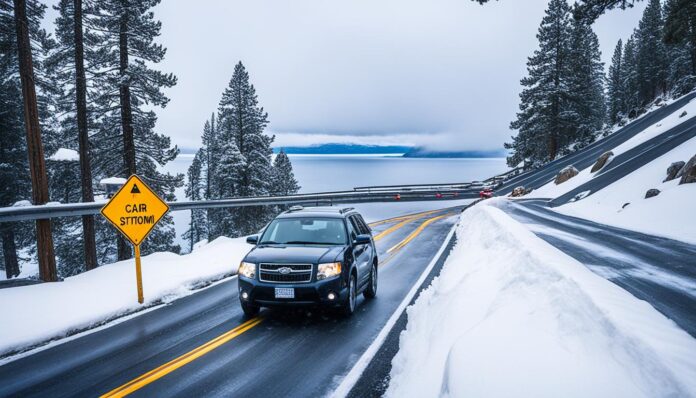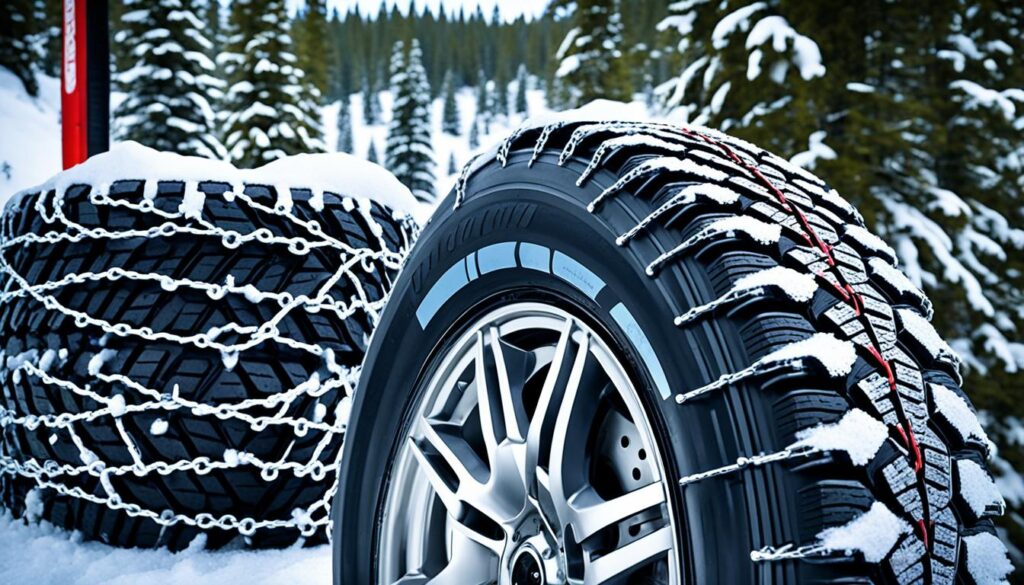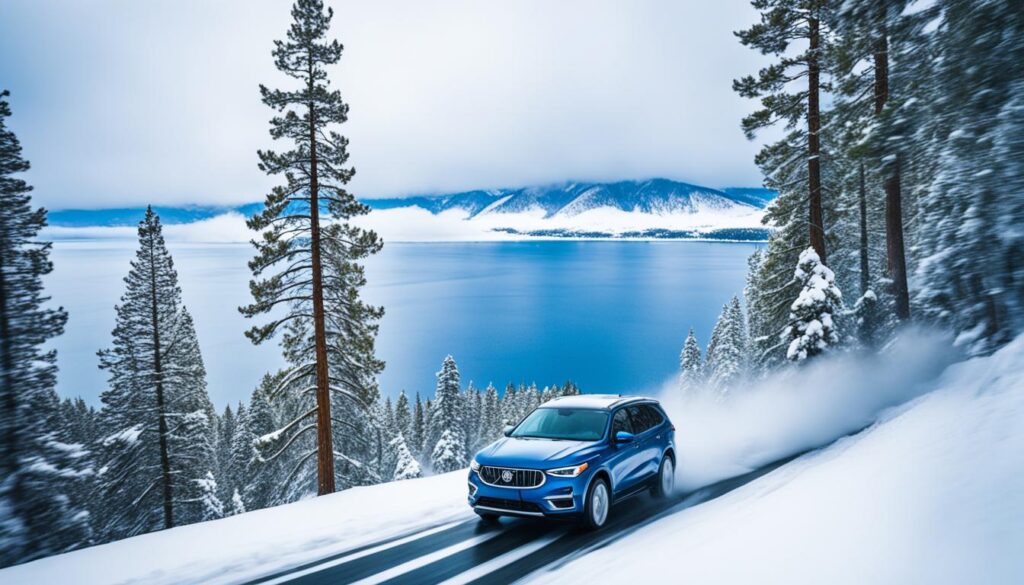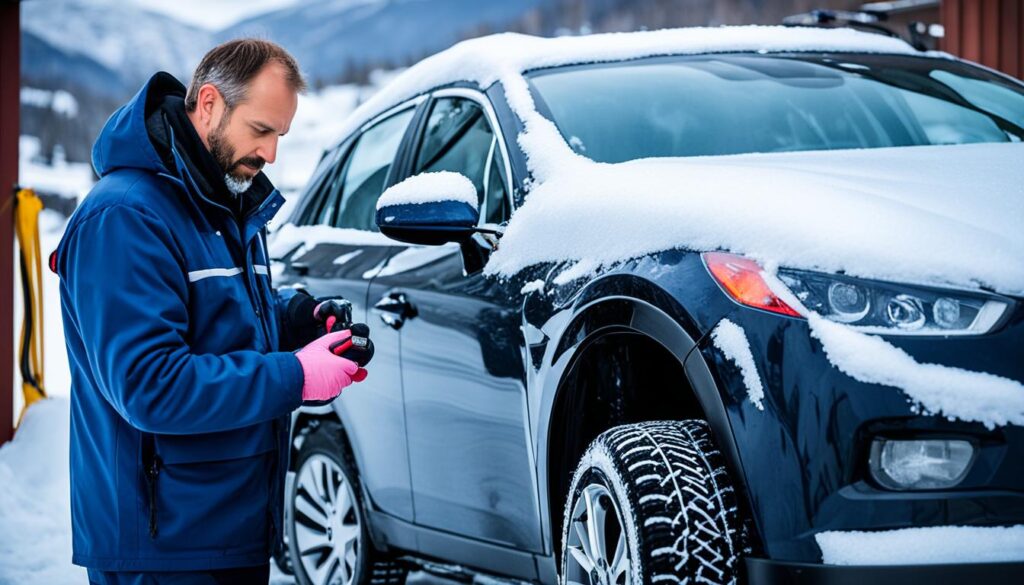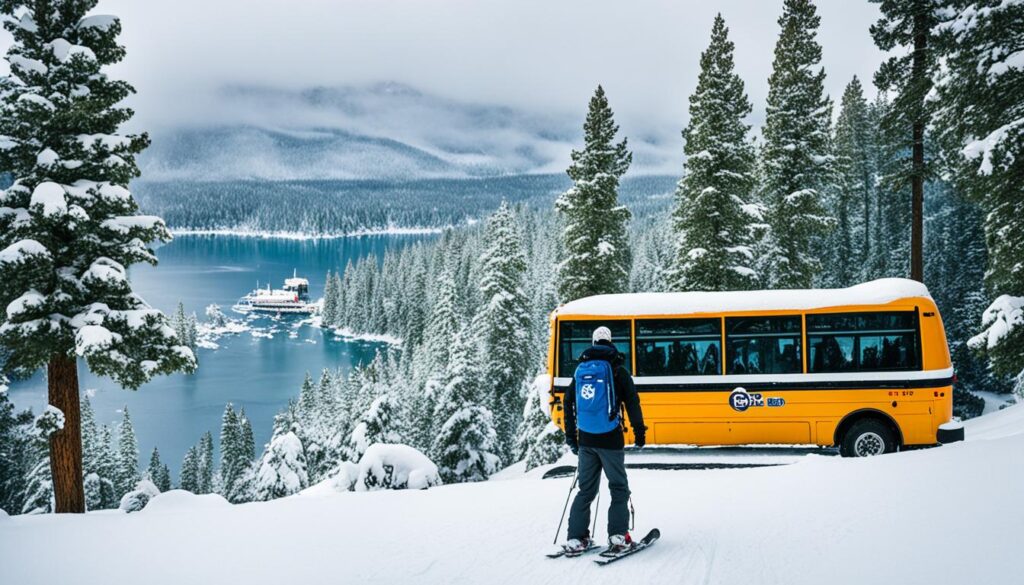Are you planning a winter getaway to Lake Tahoe? Before you hit the road, there are some special driving considerations you need to be aware of. Lake Tahoe’s stunning beauty and snow-covered landscapes offer a unique experience, but they also present challenges that can make winter driving in the region more demanding than usual. So, how can you ensure a safe and enjoyable journey through the snowy terrain of Lake Tahoe?
In this article, we will explore the essential tips and techniques for winter driving in Lake Tahoe. From understanding the winter conditions and the importance of snow tires and chains to safe driving techniques and vehicle maintenance, we have got you covered. Get ready to navigate the icy roads, conquer the mountainous terrain, and stay prepared for emergencies in the stunning winter wonderland of Lake Tahoe.
Understanding Lake Tahoe’s Winter Conditions
When it comes to winter weather, Lake Tahoe is in a league of its own. Located in the Sierra Nevada mountain range, this popular destination experiences heavy snowfall and unpredictable weather patterns during the colder months. Understanding Lake Tahoe’s unique winter conditions is crucial for safe and enjoyable travel in the area.
The winter weather in Lake Tahoe is characterized by frequent snowstorms and sub-freezing temperatures. From November to April, the region sees an average snowfall of over 300 inches, creating a winter wonderland for outdoor enthusiasts. However, these conditions can also present challenges for drivers.
“Lake Tahoe’s winter weather can be both beautiful and daunting. It’s important to be prepared for snowstorms and other weather-related challenges.”
Snowstorms in Lake Tahoe can vary in intensity, ranging from light snowfall to blizzard-like conditions. These storms can cause reduced visibility, icy roads, and hazardous driving conditions. If you’re planning a trip to Lake Tahoe during the winter, it’s crucial to stay informed about the weather forecast and road conditions to ensure a safe journey.
Winter Conditions at a Glance:
| Condition | Description |
|---|---|
| Heavy Snowfall | Lake Tahoe receives an average snowfall of over 300 inches during the winter months, creating snowy landscapes and picturesque scenes. |
| Snowstorms | Winter storms in Lake Tahoe can range from light snowfall to blizzard-like conditions, causing reduced visibility and hazardous driving conditions. |
| Icy Roads | Sub-freezing temperatures can lead to icy and slippery road surfaces, making it important to practice safe driving techniques and adjust your speed accordingly. |
| Challenging Driving Conditions | During winter, drivers in Lake Tahoe may encounter challenging conditions such as snow-packed roads, steep grades, and limited visibility. |
By understanding and preparing for Lake Tahoe’s winter conditions, you can ensure a safer and more enjoyable experience while exploring this breathtaking destination. From planning your trip around the weather forecast to practicing safe driving techniques, being proactive will help you make the most of your winter adventure in Lake Tahoe.
Snow Tires and Chains: Essential Winter Equipment
When it comes to winter driving in Lake Tahoe, having the right equipment is crucial for your safety and peace of mind. That’s why snow tires and tire chains are essential tools that every driver should have during the snowy season. These winter driving essentials provide the traction and control needed to navigate the slippery and icy roads of Lake Tahoe.
Snow tires for Lake Tahoe:
Snow tires, also known as winter tires, are specifically designed to cope with cold temperatures and snowy conditions. They are made of a softer rubber compound that stays pliable in winter weather, allowing for better grip on icy roads. Snow tires have deeper tread patterns with special channels that help channel away snow and slush, providing enhanced traction and braking performance.
Tire chains for winter driving:
Tire chains are another essential item for winter driving in Lake Tahoe. They provide additional traction by wrapping around the tire tread, increasing grip on snowy or icy surfaces. When properly installed, tire chains greatly improve your vehicle’s handling and reduce the risk of skidding or sliding. It’s important to note that tire chains should only be used when there is significant snow or ice accumulation on the roads.
Here is a comparison table summarizing the key features and benefits of snow tires and tire chains:
| Snow Tires | Tire Chains |
|---|---|
| Designed for cold temperatures and snowy conditions | Provide additional traction on snowy or icy surfaces |
| Softer rubber compound for better grip | Wrap around tire tread to increase grip |
| Deeper tread patterns with special channels to channel away snow and slush | Improve vehicle handling and reduce the risk of skidding |
| Enhanced traction and braking performance | Only used when significant snow or ice accumulation is present |
Remember, both snow tires and tire chains are valuable winter driving tools, but they serve different purposes. Snow tires are suitable for everyday winter driving in cold temperatures, while tire chains should be used when there is heavy snow or ice on the roads. Be sure to check local regulations and requirements regarding the use of tire chains in Lake Tahoe.
AWD and 4WD Vehicles: Are They Necessary?
When it comes to winter driving in Lake Tahoe, the question of whether to invest in an all-wheel drive (AWD) or four-wheel drive (4WD) vehicle often arises. While these types of vehicles may offer certain advantages in snowy and icy conditions, it’s important to understand their pros and cons before making a decision. Let’s take a closer look.
AWD Vehicles for Lake Tahoe
AWD vehicles are designed to provide power to all four wheels simultaneously, offering improved traction on slippery surfaces. This can be particularly beneficial when navigating the snowy terrain of Lake Tahoe. AWD vehicles distribute power automatically to the wheels with the most traction, which can help maintain control and stability in challenging driving conditions.
However, it’s worth noting that AWD does not guarantee invincibility on snowy roads. While it can enhance traction, it does not eliminate the need for cautious driving and proper winter tires. It’s still important to adapt your driving style to the conditions and ensure that your vehicle is properly equipped for winter travel.
4WD Vehicles in Winter
4WD vehicles, on the other hand, are specifically designed for off-road and rugged conditions. They allow the driver to manually switch between two-wheel drive and four-wheel drive modes, providing enhanced traction and control in challenging terrains. Many 4WD vehicles also offer low-range settings for additional torque and power in extreme snow and ice conditions.
While 4WD can be advantageous for driving in deep snow or traversing steep inclines, it’s important to remember that it’s not a substitute for proper winter driving techniques. It’s still crucial to drive at safe speeds, maintain a proper following distance, and equip your vehicle with appropriate winter tires and tire chains if required.
Always remember that regardless of the type of vehicle you choose, safe winter driving practices and proper preparation are key to navigate Lake Tahoe’s winter conditions successfully.
Pros and Cons of AWD and 4WD Vehicles
| Pros | Cons |
|---|---|
| Improved traction in snowy conditions | Higher upfront cost |
| Enhanced control and stability | Potentially lower fuel efficiency |
| Increased capability in off-road situations | Additional maintenance and repair costs |
Ultimately, the decision to invest in an AWD or 4WD vehicle for Lake Tahoe’s winter conditions depends on your individual driving needs and preferences. If you regularly encounter deep snow or off-road situations, a 4WD vehicle may be more suitable. However, if you primarily drive on plowed roads or want added traction in everyday winter driving, an AWD vehicle can be a practical choice.
Regardless of your vehicle choice, it’s important to remember that no vehicle can completely eliminate the risks associated with winter driving. Always prioritize safety by practicing defensive driving habits, monitoring road conditions, and ensuring your vehicle is equipped for winter travel.
Safe Driving Techniques for Snowy Roads
Driving on snowy and icy roads in Lake Tahoe requires special caution and adherence to safe driving techniques. To ensure your safety and the safety of others on the road, follow these essential tips:
- 1. Maintain a safe speed: Reduce your speed and maintain a safe distance from the vehicle in front of you. It takes longer to stop on icy roads, so slow down to avoid skidding or losing control.
- 2. Use gentle braking techniques: Apply the brakes gently and avoid abrupt or sudden braking, which can cause your vehicle to skid. If your vehicle has an anti-lock braking system (ABS), keep your foot on the brake pedal firmly and let the system do its job.
- 3. Be cautious while accelerating: Gradually accelerate to avoid spinning your tires or losing traction. If your vehicle starts to skid, release the accelerator and steer in the direction you want to go.
- 4. Steer smoothly: Avoid sudden or jerky movements of the steering wheel. Make gentle and gradual turns to maintain control of your vehicle.
- 5. Watch out for black ice: Be aware of black ice, a transparent layer of ice that forms on the road surface, making it extremely slippery. Drive with extra caution on bridges, overpasses, and shaded areas where black ice is more likely to form.
- 6. Use your headlights: Keep your headlights on, even during the day, to increase your visibility to other drivers. Clear any snow or ice from your headlights to ensure maximum effectiveness.
If you find yourself skidding on icy roads, remain calm and follow these steps:
- 1. Don’t panic: Avoid overreacting or making sudden movements that can worsen the skid.
- 2. Steer into the skid: Turn your steering wheel in the direction of the skid to help regain control of your vehicle.
- 3. Ease off the accelerator: Release the accelerator pedal to slow down and help regain traction.
- 4. Avoid sudden braking: Ease off the brakes to prevent further skidding. Brake gently once you have regained control.
Remember, practicing safe driving techniques is crucial when navigating snowy and icy roads in Lake Tahoe. By following these tips, you can reduce the risk of accidents and ensure a safe and enjoyable winter driving experience.
Vehicle Maintenance for Winter Driving
Proper vehicle maintenance is crucial for safe and reliable winter driving in Lake Tahoe. Cold temperatures, snow, and icy conditions can put extra strain on your vehicle, so it’s important to prepare it accordingly. Here are some essential maintenance tasks to help you prepare your car for winter:
- Tire Inspection: Check your tires regularly for wear and proper inflation. Winter tires are highly recommended for improved traction on snow and ice. Ensure that the tread depth meets the legal requirements and consider replacing worn tires.
- Brake Check: Have your brakes inspected by a qualified technician to ensure they are in good working condition. Cold weather can affect brake performance, so it’s essential to have them checked and serviced if needed.
- Fluid Levels: Check and top up all essential fluids, including engine oil, coolant, brake fluid, and windshield washer fluid. Cold temperatures can cause fluids to thicken or freeze, impacting their effectiveness.
- Battery Maintenance: Cold weather can drain your vehicle’s battery faster. Have your battery tested to ensure it’s in good working condition. Clean any corrosion around the terminals and consider replacing an old battery if necessary.
- Heating and Defrosting System: Ensure your vehicle’s heating and defrosting systems are working correctly. It’s essential to have clear visibility and a warm interior during winter driving.
| Maintenance Task | Frequency |
|---|---|
| Tire Inspection | Every month |
| Brake Check | Annually |
| Fluid Levels | Every month |
| Battery Maintenance | Annually |
| Heating and Defrosting System | Annually |
Regular vehicle maintenance is not only essential for your safety but also helps prevent breakdowns that could leave you stranded in harsh winter conditions.
By following these maintenance tips, you can ensure that your vehicle is in optimal condition for winter driving in Lake Tahoe. A well-maintained car will provide better traction, handling, and reliability, improving your overall safety on the road.
Navigating Lake Tahoe’s Mountainous Terrain
Driving in Lake Tahoe’s mountainous terrain during winter can be a thrilling experience, but it also brings unique challenges that require careful preparation and attention. The steep grades, winding roads, and limited visibility demand specific strategies to ensure your safety and enjoyment on the road.
Handling Steep Grades
When driving on steep grades in Lake Tahoe, it’s crucial to maintain control of your vehicle. Here are some tips to help you navigate these challenging sections:
- Use a lower gear: Shift into a lower gear to help your vehicle maintain control and avoid excessive braking on steep descents.
- Apply gentle braking: If you need to slow down while descending, apply light and steady pressure to the brakes to avoid overheating them.
- Stay focused: Keep your eyes on the road ahead, paying attention to any potential hazards or changes in road conditions.
Navigating Curvy Roads
The curvy roads of Lake Tahoe require careful navigation, especially during winter. Here are some suggestions to help you drive safely:
- Reduce your speed: Slow down when approaching curves to maintain control of your vehicle and reduce the risk of skidding.
- Stay centered: Keep your vehicle in the center of your lane to have enough space to maneuver around the curves.
- Avoid sudden maneuvers: Make smooth and gradual turns, braking and accelerating gently to maintain stability and traction.
Dealing with Limited Visibility
Limited visibility is a common challenge in Lake Tahoe during winter, especially when snowfall or fog obstructs the road. To cope with these conditions:
- Use your lights: Turn on your headlights whenever visibility is reduced to make your vehicle more visible to other drivers.
- Drive slower: Reduce your speed to give yourself more time to react to any unexpected obstacles or changes in the road ahead.
By following these tips and staying alert, you can confidently navigate Lake Tahoe’s mountainous terrain and enjoy the breathtaking beauty of the region.
Proper Emergency Preparedness
In the event of an emergency while driving in Lake Tahoe’s winter conditions, it is crucial to be prepared. Taking the time to assemble a winter emergency kit and familiarizing yourself with local roadside assistance services can help ensure your safety and the well-being of your passengers. Here are some essential items to include in your winter emergency kit:
Winter Emergency Kit Checklist:
- Snow shovel – To clear snow around your vehicle
- Ice scraper – For removing ice from your windshield and windows
- Blankets – To keep warm in case of extended wait times
- Extra clothing and gloves – To stay dry and protect against the cold
- Flashlight – With extra batteries for visibility in low-light conditions
- Portable phone charger – To ensure you can contact help if needed
- Non-perishable snacks and water – For sustenance during unexpected delays
- First aid kit – Including basic medical supplies
- Emergency contact information – Written down or saved in your phone
- Roadside flares or reflectors – To increase visibility in case of a breakdown
In addition to having a well-stocked winter emergency kit, it’s important to be aware of the local roadside assistance services available in Lake Tahoe. Knowing how to reach out for help can provide peace of mind during an emergency situation. Here are some local roadside assistance options:
Local Roadside Assistance Services:
- Lake Tahoe Towing – Contact them at (555) 123-4567 for prompt assistance
- Sierra Roadside Rescue – Available 24/7 at (555) 987-6543
- Tahoe Auto Repair – Call them at (555) 246-1357 for reliable roadside services
By being prepared with a winter emergency kit and having the contact information for local roadside assistance services, you can navigate Lake Tahoe’s winter conditions with confidence and ensure your safety on the road.
Understanding Chain Control Systems
In winter, Lake Tahoe experiences heavy snowfall and challenging road conditions that require special precautions for safe travel. Understanding the chain control systems implemented in the region is essential to navigate these conditions effectively.
Caltrans, the California Department of Transportation, is responsible for monitoring and managing road conditions in Lake Tahoe and other areas of California. Caltrans determines when chain control is necessary based on current weather conditions and road conditions.
Caltrans Chain Requirements
Caltrans has established specific requirements for using tire chains in Lake Tahoe during winter. These requirements help ensure sufficient traction on slippery roads and reduce the risk of accidents. It is important to familiarize yourself with the different chain requirements and follow them accordingly.
The chain requirements in Lake Tahoe are classified into three levels:
- R1: The R1 chain control requires all vehicles to have chains on their tires, except for vehicles equipped with snow tires.
- R2: The R2 chain control requires all vehicles to have chains on their tires, regardless of whether they have snow tires.
- R3: The R3 chain control is reserved for extreme winter conditions and mandates that all vehicles, including those with snow tires, must have chains on their tires.
It is crucial to regularly check the Caltrans website or call their information hotline before your trip to Lake Tahoe to stay updated on the current chain control requirements. By doing so, you can ensure that you have the necessary equipment and comply with the guidelines, promoting a safer and smoother journey.
Tips for Using Tire Chains
Using tire chains correctly is essential for their effectiveness and your safety. Here are some tips to keep in mind:
- Practice installing chains before your trip to become familiar with the process. This will save you time and reduce frustration when you encounter chain control areas.
- Choose the appropriate type and size of chains for your vehicle. Refer to your vehicle’s manual or consult with a professional if you are unsure.
- Ensure that the chains fit securely and are properly tightened. Loose or improperly fitted chains can reduce traction and may cause damage to your tires or vehicle.
- Don’t exceed the recommended speed limit when driving with chains. Slow down and drive cautiously to maintain control.
- When you reach areas without chain control, promptly remove the chains to prevent unnecessary wear and damage to both the chains and the road.
Remember, chain control is enforced for your safety and the safety of others on the road. By understanding the chain control systems and following Caltrans’ requirements, you can confidently and safely navigate the winter conditions in Lake Tahoe.
| Chain Control Requirements | Applicable Vehicles | Exceptions |
|---|---|---|
| R1 | All vehicles except those with snow tires | Vehicles with snow tires |
| R2 | All vehicles | N/A |
| R3 | All vehicles, including those with snow tires | N/A |
Note: The above is a summary of Caltrans chain control requirements. Please visit the Caltrans website or contact their information hotline for the most up-to-date and detailed information regarding chain control in Lake Tahoe.
Staying Informed: Monitoring Road Conditions
When it comes to winter travel in Lake Tahoe, staying informed about current road conditions is crucial for a safe and hassle-free journey. The unpredictable weather and snowy terrain make it vital to have real-time updates on the state of the roads. By keeping tabs on Lake Tahoe road conditions, you can plan your travel routes accordingly and make informed decisions about when and where to travel.
There are several resources and tools available to help you monitor road conditions in Lake Tahoe:
1. Caltrans Website
Caltrans, the California Department of Transportation, provides valuable information about road conditions through their website. The Caltrans website offers real-time updates, including traffic alerts, chain control requirements, and closures. It is a go-to resource for accurate and up-to-date information on driving conditions in Lake Tahoe.
2. Mobile Apps
In this digital age, many mobile apps provide real-time updates on road conditions. Apps such as Waze, Google Maps, and Caltrans QuickMap can help you navigate through Lake Tahoe’s winter roads. These apps provide traffic information, alternative route suggestions, and even user-generated reports on road conditions.
3. Social Media
Social media platforms like Twitter can be valuable sources of information for monitoring road conditions. Organizations like Caltrans and local law enforcement agencies often provide updates and alerts through their official Twitter accounts. By following these accounts, you can receive timely information directly on your feed.
4. Local News and Radio Stations
Local news outlets and radio stations in the Lake Tahoe region often provide regular updates on road conditions, particularly during winter weather events. Tuning in to local news broadcasts or listening to radio stations can give you real-time information and insights from local authorities and experienced weather reporters.
By utilizing these resources and tools, you can stay informed about the latest Lake Tahoe road conditions and make well-informed decisions for your winter travel. Remember, it is always better to be prepared and aware of the conditions before hitting the road.
Public Transportation and Alternate Options
If you prefer not to drive or are visiting Lake Tahoe without a personal vehicle, there are alternative transportation options available. From public transportation services to other convenient alternatives, you can explore these options to navigate the area without the need for your own car. Let’s take a look at what’s available:
1. Lake Tahoe Public Transportation
Lake Tahoe offers a reliable public transportation system that allows you to travel conveniently to various destinations around the region. The public transportation options include:
| Transportation Service | Features |
|---|---|
| 1. Tahoe Truckee Area Regional Transit (TART) | – Bus service connecting multiple communities – Regular routes and schedules – Affordable fares |
| 2. South Tahoe Area Transit Authority (STATA) | – Bus service in South Lake Tahoe – Routes covering popular tourist areas – Convenient schedules |
These public transportation services offer a convenient and cost-effective way to explore Lake Tahoe without driving. Whether you need to get to popular attractions, ski resorts, or nearby towns, the public transportation system can easily get you there.
2. Ridesharing Services
In addition to public transportation, ridesharing services like Uber and Lyft are available in Lake Tahoe. These services provide a convenient way to travel within the region, offering rides at the touch of a button. Simply download the app, request a ride, and a driver will pick you up from your location.
3. Shuttle Services
Several shuttle services operate in Lake Tahoe, offering transportation to and from popular destinations. These shuttles are particularly convenient for traveling to ski resorts, casinos, and other tourist attractions. Some resorts and hotels also provide their own shuttle services for guests.
4. Bicycle Rentals
For those who enjoy cycling, Lake Tahoe offers bicycle rentals at various locations. Renting a bicycle allows you to explore the area at your own pace while enjoying the beautiful scenery. Many rental shops provide helmets and trail maps to enhance your cycling experience.
By taking advantage of these alternate transportation options, you can enjoy your visit to Lake Tahoe without the need for a personal vehicle. Whether you’re a local or a tourist, these convenient options ensure you can explore the area comfortably and sustainably.
Conclusion
In conclusion, when it comes to winter travel in Lake Tahoe, it’s crucial to be well-prepared and informed. By understanding the unique winter conditions and special driving considerations of the region, you can ensure a safe and enjoyable journey.
First and foremost, equipping your vehicle with snow tires and tire chains is essential for navigating the snowy roads of Lake Tahoe. These winter driving essentials provide the traction needed to safely maneuver through the challenging terrain.
Additionally, practicing safe driving techniques such as maintaining a safe speed, utilizing proper braking techniques, and knowing how to handle skidding will help you stay in control and avoid accidents on slippery roads.
Furthermore, proper vehicle maintenance, including checking tires, brakes, and fluids, is crucial for winter driving in Lake Tahoe. Regular maintenance ensures that your vehicle is in top condition and ready to handle the cold weather and mountainous terrain.
By being prepared with an emergency kit and staying informed about road conditions through real-time updates, you can respond effectively to any unexpected situations that may arise during your winter travel in Lake Tahoe. Safety should always be a top priority.
Remember, whether you’re a local resident or a visitor, understanding and following these special driving considerations will help you navigate Lake Tahoe’s winter wonderland with confidence, ensuring a safe and enjoyable travel experience.




























